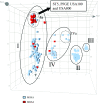Overlapping population structures of nasal isolates of Staphylococcus aureus from healthy Dutch and American individuals
- PMID: 17977984
- PMCID: PMC2224299
- DOI: 10.1128/JCM.00887-07
Overlapping population structures of nasal isolates of Staphylococcus aureus from healthy Dutch and American individuals
Abstract
To understand Staphylococcus aureus nasal carriage and its relationship with subsequent disease, insight into the natural (nonclinical) bacterial population structure is essential. This study investigated whether the distributions of S. aureus genotypes that cause colonization differ by geographic locales. High-throughput amplified fragment length polymorphism (AFLP) analysis was performed on nasal isolates of S. aureus from healthy American (n = 391) and Dutch (n = 829) volunteers. In total, 164,970 binary outcomes, covering 135 different markers per isolate, were scored. Methicillin resistance was defined for all strains; pulsed-field gel electrophoresis typing was performed for the American isolates. The overall population structures of the American and Dutch S. aureus isolates were comparable. The same four major AFLP clusters (I to IV) and subclusters were identified for both collections. However, the Dutch methicillin-susceptible S. aureus (MSSA) isolates were overrepresented in AFLP cluster III (P = 0.0016). Furthermore, the majority of the American methicillin-resistant S. aureus isolates (90.5%) were located in AFLP cluster I (P < 0.0001). This result identifies differences in the local prevalence of certain S. aureus genotypes. AFLP clusters II and III, which represent multilocus sequence typing clonal complexes 30 and 45, respectively, account for 46.4% of all MSSA isolates in the study, suggesting that these two lineages have evolved as extremely successful pandemic colonizers of humans. In conclusion, the overall population structures of American and Dutch nasal carriage isolates of S. aureus are surprisingly similar, despite subtle geographic differences in the prevalence of certain S. aureus genotypes.
Figures




References
-
- Bogaert, D., A. van Belkum, M. Sluijter, A. Luijendijk, R. de Groot, H. C. Rumke, H. A. Verbrugh, and P. W. Hermans. 2004. Colonisation by Streptococcus pneumoniae and Staphylococcus aureus in healthy children. Lancet 3631871-1872. - PubMed
-
- Hofman, A., D. E. Grobbee, P. T. de Jong, and F. A. van den Ouweland. 1991. Determinants of disease and disability in the elderly: the Rotterdam Elderly Study. Eur. J. Epidemiol. 7403-422. - PubMed
-
- Keygene, N. V., M. F. O. Zabeau, and P. A. J. Vos. March 1993. Selective restriction fragment amplification: a general method for DNA fingerprinting. European patent 0 534 858 B2.
-
- Keygene, N. V., M. F. O. Zabeau, and P. A. J. Vos. April 2000. Selective restriction fragment amplification: a general method for DNA fingerprinting. U.S. patent 6,045,994.
-
- Kuehnert, M. J., D. Kruszon-Moran, H. A. Hill, G. McQuillan, S. K. McAllister, G. Fosheim, L. K. McDougal, J. Chaitram, B. Jensen, S. K. Fridkin, G. Killgore, and F. C. Tenover. 2006. Prevalence of Staphylococcus aureus nasal colonization in the United States, 2001-2002. J. Infect. Dis. 193172-179. - PubMed
Publication types
MeSH terms
Substances
LinkOut - more resources
Full Text Sources

